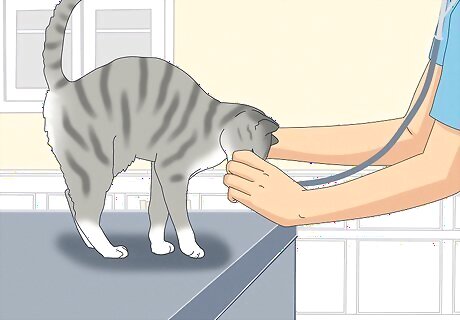
views
Considering the Requirements of a Cat

Ask yourself why you want to get a cat. It is important to understand the motivation behind wanting to get a cat in the first place in order to choose the best possible cat to bring home. Some common reasons include: Wanting unconditional love and constant companionship To fill a void created by the loss of another pet or companion Wanting a friend for your child while also teaching them about responsibility Wanting to take care of someone every day

Consider whether you are ready for the long-term commitment. Owning a pet is a big responsibility, and the decision to get a cat can mean signing up for these responsibilities for about 15 to 18 years. It is important to be aware that over the next decade plus, this cat will be in your life as a constant companion, but also as a constant obligation. Be sure you are willing to take care of a cat throughout your life and theirs before going any further in the process.

Determine whether you can afford to get a cat. In addition to the initial cost of the cat, which can be very high if you choose to go to a breeder, you also need to consider other ownership expenses. Keep in mind you will also need to pay for food, visits to the veterinarian, identification tags, microchipping, and other incidentals, which can really add up quickly. The ASPCA estimates that the first year alone will cost a cat owner about $1,035.

Consider other complications of cat ownership. You may really want to get a cat, and you may have the means to do so, but there are a few other requirements you should consider before deciding that a cat is the right choice at this point in your life: Do you have any other pets and will they react well to a new cat? Are you allowed to have cats at your current residence? Will your work and social life allow time to care for, and interact with, a new cat? What would you do with your cat if you went on vacation? Do you, or anyone else that would commonly interact with the cat, have allergies to cats, cat hair, dirt, or dander? Do you have children who may need a cat with a particular type of temperament?
Deciding Where to Look for the Perfect Cat

Go to an animal shelter. While most shelter cats are mixed-breed, it is possible to find purebred cats at a shelter. Adopting a shelter cat also means it has been checked by a veterinarian and is often already spayed or neutered pre-adoption. This is one of the lowest costing options, and adopting a cat also gives them a second chance at life, which is a great cause.

Contact a rescue group. There are many organizations dedicated to rescuing cats and finding someone to adopt them. Some organizations take in any type of cat, while others are dedicated to rescuing specific breeds. Do some research online or contact your local animal shelter for suggestions, as they often work together. Many rescue groups don’t have an adopting fee and instead have a recommended “donation fee” that is relatively inexpensive.

Avoid pet stores. Be wary of buying a cat from a pet store. Many of these kittens come from animal mills, which focus on breeding as many cats as possible rather than safely breeding a few quality litters. These cats are often born with congenital abnormalities and raised in confined, crowded conditions, which can cause behavioral issues. They will also cost a lot more money than getting a cat from a shelter or rescue group, often costing hundreds of dollars.

Research breeders. If you have a particular breed in mind, do some thorough research to find an accredited breeder with a great reputation. Because purebred cats are also much more expensive (think hundreds, even thousands, of dollars), be sure to research median prices so you know whether or not you are paying an appropriate amount.

Take in a stray. It is important to first determine if the cat in question is in fact a stray cat; look for "lost" or "missing" fliers in your neighborhood, contact the local shelters, and take the cat to a veterinarian to check if it is microchipped. If it is a stray, it is very important to take the cat to a veterinarian to be checked for diseases and to be spayed/neutered immediately.
Choosing the Best Cat

Research the temperaments of different breeds. Different breeds of cats have distinct characteristics, and it is important to do some research to determine the best breed to fit your lifestyle. While less than 10% of cats are considered “purebred” to one specific breed, an understanding of the breeding groups in general will be very helpful even if you are adopting a common house cat: Natural breeds: These cats have long, thick coats developed in cold climates; heavy, square bodies; and are the most sedentary group of the three purebred groupings. Common breeds within this group are American and British shorthairs, Persians, and Maine coon cats. Semi-foreign or Hybrids: Considered an in-between group, these cats have slightly oval eyes; moderately wedge-shaped heads; and a leaner, more muscular body than the other breeds. They have a moderate energy level in comparison, except for the Abyssinian breed, which is high energy. Other common breeds within this group are the Russian blues and Ocicats. The Orientals: These cats originated in warmer climates and so they have very little body fat, lighter coats, and very long legs, tails, ears, and bodies. This group is the most active and talkative of the three purebred groupings. Common breeds within this group are Siamese, Burmese, and Cornish rexes.

Consider the cat age that is most appropriate for you. It is important to consider the time you have available to train and play with your cat, as well as your expectations for its behavior. If you work full time or have young children, it might be best to adopt an older cat since kittens and adolescents are a lot of work to train and watch over. If this is your first cat, try to avoid cats that are very demanding (of your attention, of their space, etc.) as it may be too big a challenge for a beginner.

Find a cat whose personality is a great match with yours. After doing some research to determine the best breeds for your lifestyle, it is important to realize that this is just a “best guess.” Be sure to go and interact with your cat in person a few times before making a decision. Also, adoption counselors at shelters often have great advice to help you find a cat whose personality matches your own.

Discuss introductions with the breeder or shelter. It is very important that any cat you get feels safe and comfortable interacting with the other people and pets in your life already. When visiting the shelter or breeder, be sure to bring your kids, partner, or anyone else that will have regular contact with the cat along with you. If you have existing pets, talk to the breeder or the shelter counselors about the best way to introduce the pets to see if there are any potential issues.

Check for obvious signs of illness. A breeder will have a better understanding of the cat’s history and tendencies, but an animal shelter or rescue group will only be able to hypothesize about a cat’s past illnesses and elaborate on its current state. While no shelter would want to release a sick cat for adoption, it is still important to educate yourself about common signs of illness in cats so you can ask questions and make observations: Changes in water intake (both drinking more and drinking less) can indicate that the cat has diabetes or kidney disease. Unexpected weight loss or weight gain despite normal eating habits can indicate diabetes or hyperthyroidism. Bad breath can mean tooth decay, dental disease, or a digestive disorder, while sweet or fruity-smelling breath can be a sign of diabetes. Pay attention to the cat’s grooming habits. If a once well-groomed cat starts to appear unkempt, this is a sure sign of potential illness. Alternatively, over-grooming can indicate that the cat is very stressed out, anxious, in pain, or has allergies.

Start preparing for your cat to come home. Before bringing your cat home, pick out a local veterinarian and schedule a visit within the first couple of days of its arrival. Be sure to ask for any medical records from the shelter or breeder! Get your house in order and buy everything that the cat will need in your home. For a list, see "Things You'll Need" below.
Bringing Your Cat Home

Set up an area for your cat. Because cats are very territorial, it can be extra stressful for a cat to come into a home full of new smells and dark spaces. To help ease the transition, create the ideal cat territory for your cat: Find a small space for the cat to call home for the first few days or weeks, ideally with enough room for the cat’s water, food, and litter box, as well as a space for you to sit and interact (slowly at first) with your new pet. Fill a litter box with a few inches (about 6 cm) of litter and put it somewhere within the small space that will provide some privacy for the cat to use it undisturbed (for example, drape a cloth over the edge of a counter, like a curtain). Keep the food and water bowls separate from the litter box area. Provide the cat with something to scratch, like a post or a mat you can purchase at pet stores, and keep one in each room. If you need to, encourage the cat to scratch those (instead of your couch!) by putting some catnip on the scratching surfaces.

Introduce the cat to your home in a controlled environment. Have the doors closed and let the cat smell and listen to the environment, making sure to do this with the cat in the carrier if there are other pets or young children in the area. Show your cat the special area you created for it and where the litter box, bed, and food are.

Introduce the new cat to your other pets slowly. Cats are very territorial animals so introductions should be made gradually. Keep your pets in separate rooms and first share their scents with each other by rubbing a towel on each and swapping them. Feed the pets on opposite sides of a closed door, and slowly begin opening the door at different times of day. Keep in mind it could take weeks or months till they feel comfortable with each other!

Expect a level of nervousness in the first few days. You should expect the cat to hide and not eat very much food for the first days or even weeks. If you have other pets, be aware that it will take a month or more for them to become acclimated to a new pet. Don’t force the cat to come to you, and understand that some cats hide and don’t come out at all when you are around for a while. Just give the cat time!

Provide for your cat. Even if the cat is hiding from you, be sure to provide it with food twice a day and always have fresh water readily available. If the cat is shy and avoiding eating during this adjustment period, it is very important that they are still hydrating.

Take your cat to the vet within the first week for a check-up. Take your cat to the pre-scheduled vet visit to have them vaccinated and de-wormed, if necessary. Be sure to provide the vet with any records you received from the breeder or shelter. It is highly recommended that you also have a microchip implanted for identification if it needs surgery or gets lost.

Look for signs that your cat is adjusting. Note when your cat starts exploring outside of the safe area you created for them, and start opening more doors and widening the space they have to take in. Be sure to make an effort not to scare or startle the cat during this time! If the cat is ready to play, keep your cat from getting bored by providing it with toys and interacting with it. Cats love to play! Signs that your cat isn't adjusting so well can include going to the bathroom outside of the litter box, not eating, and changes in bowel movements. If your cat is showing any of these symptoms, talk to a vet since they could be a sign that something is wrong.

Enjoy having a cat! Now that you have researched the type of cat to get, sought the cat out and purchased it, prepared your home for the cat, and waited patiently as it adjusted, enjoy the companionship and love of your new cat! The bond you will share will be a wonderful and long-lasting one.




















Comments
0 comment